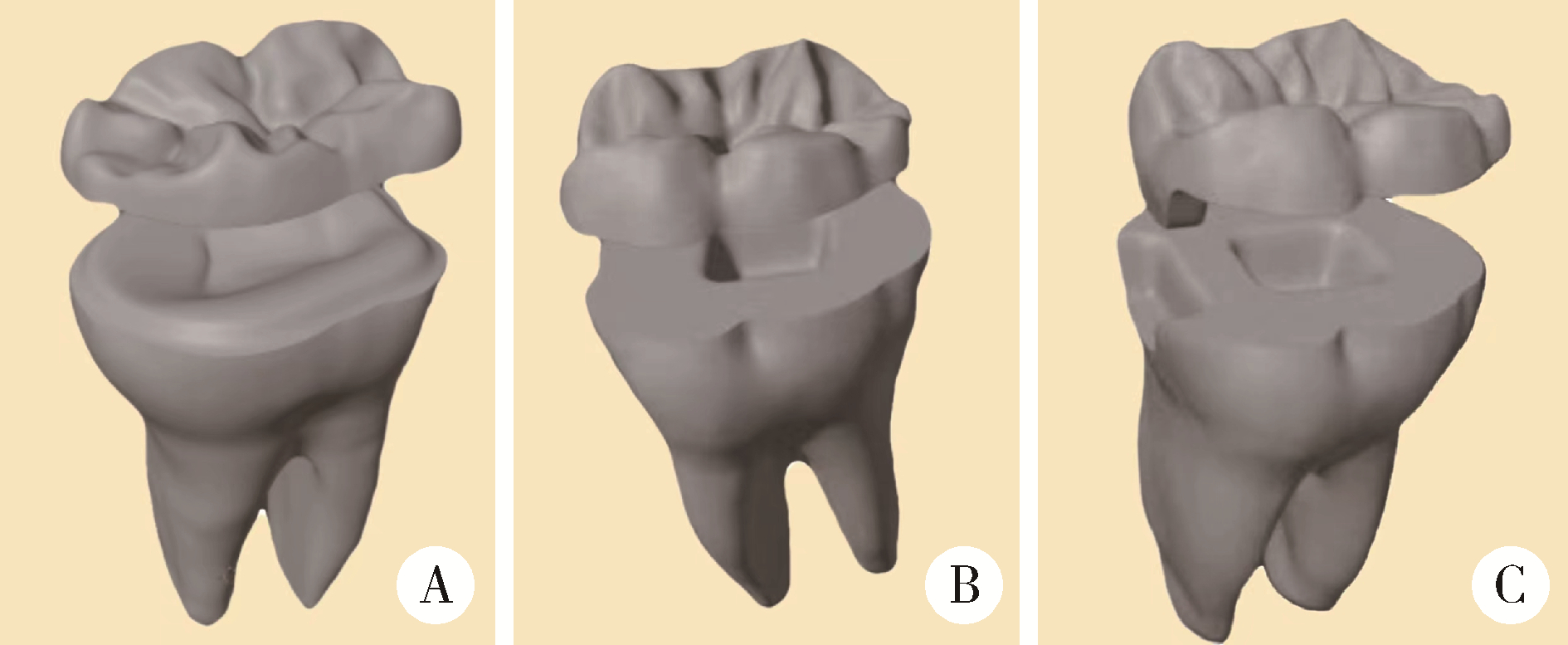Journal of Peking University (Health Sciences) ›› 2024, Vol. 56 ›› Issue (1): 88-92. doi: 10.19723/j.issn.1671-167X.2024.01.014
Previous Articles Next Articles
Four-year follow-up study of onlay and occlusal veneer restorations on posterior teeth
Meichen WU1,Tongkai XU2,Wei AN1,3,Zhongning LIU1,Ting JIANG1,*( )
)
- 1. Department of Prosthodontics, Peking University School and Hospital of Stomatology & National Center of Stomatology & National Clinical Research Center for Oral Diseases & National Engineering Research Center of Oral Biomaterials and Digital Medical Devices & Beijing Key Laboratory of Digital Stomatology & NHC Research Center of Engineering and Technology for Computerized Dentistry & NMPA Key Laboratory for Dental Materials, Beijing 100081, China
2. Department of second general dentistry, Peking University School and Hospital of Stomatology, Beijing 100081, China
3. Department of Dental Implant, Stomatology Hospital of Kunming Medical University, Kunming 650032, China
CLC Number:
- R783
| 1 | Ferro KJ . The glossary of prosthodontic terms: Ninth edition[J]. J Prosthet Dent, 2017, 117 (Suppl 5): e1- e105. |
| 2 |
Mario D , Mario A , Allegra C , et al. The influence of indirect bonded restorations on clinical prognosis of endodontically treated teeth: A systematic review and meta-analysis[J]. Dent Mater, 2022, 38 (8): e203- e219.
doi: 10.1016/j.dental.2022.06.018 |
| 3 |
Naik VB , Jain AK , Rao RD , et al. Comparative evaluation of clinical performance of ceramic and resin inlays, onlays, and overlays: A systematic review and meta analysis[J]. J Conserv Dent, 2022, 25 (4): 347- 355.
doi: 10.4103/jcd.jcd_184_22 |
| 4 |
Schlichting LH , Resende TH , Reis KR , et al. Ultrathin CAD-CAM glass-ceramic and composite resin occlusal veneers for the treatment of severe dental erosion: An up to 3-year randomized clinical trial[J]. J Prosthet Dent, 2022, 128 (2): 158.e1- 158.e12.
doi: 10.1016/j.prosdent.2022.02.009 |
| 5 |
Zhang H , Lv P , Du W , et al. Comparison of fracture load and surface wear of microhybrid composite and ceramic occlusal veneers[J]. J Prosthodont, 2020, 29 (5): 387- 393.
doi: 10.1111/jopr.13156 |
| 6 |
Ting J , Shuhui H , Hongqiang Y , et al. CAD/CAM ceramic overlays to restore reduced vertical dimension of occlusion resulting from worn dentitions: A case history report[J]. Int J Prosthodont, 2017, 30 (3): 238- 241.
doi: 10.11607/ijp.5146 |
| 7 |
Kassis C , Khoury P , Mehanna CZ , et al. Effect of inlays, onlays and endocrown cavity design preparation on fracture resistance and fracture mode of endodontically treated teeth: An in vitro study[J]. J Prosthodont, 2021, 30 (7): 625- 631.
doi: 10.1111/jopr.13294 |
| 8 |
Edelhoff D , Sorensen JA . Tooth structure removal associated with various preparation designs for anterior teeth[J]. J Prosthet Dent, 2002, 87 (5): 503- 509.
doi: 10.1067/mpr.2002.124094 |
| 9 | 谭桂芳, 吴娜, 郭大伟, 等. 全瓷高嵌体用于后牙根管治疗后牙体修复的临床回顾性研究[J]. 口腔颌面修复学杂志, 2021, 22 (6): 423- 429. |
| 10 | 许伟伟, 单显峰, 管庆华, 等. 全瓷高嵌体在后牙根管治疗后牙体修复中的效果观察[J]. 中国实用医药, 2022, 17 (24): 83- 85. |
| 11 | 况金鑫, 吴昊泽, 潘雅婷, 等. 计算机辅助设计与辅助制作全瓷嵌体冠修复无髓后牙效果的5年回顾性研究[J]. 中华口腔医学杂志, 2022, 57 (10): 1043- 1047. |
| 12 |
Vagropoulou GI , Klifopoulou GL , Vlahou SG , et al. Complications and survival rates of inlays and onlays vs complete coverage restorations: A systematic review and analysis of studies[J]. J Oral Rehabil, 2018, 45 (11): 903- 920.
doi: 10.1111/joor.12695 |
| 13 |
Pjetursson BE , Sailer I , Makarov NA , et al. All-ceramic or metal-ceramic tooth-supported fixed dental prostheses (FDPs)? A systematic review of the survival and complication rates. Part Ⅱ: Multiple-unit FDPs[J]. Dent Mater, 2015, 31 (6): 624- 639.
doi: 10.1016/j.dental.2015.02.013 |
| 14 |
Abduo J , Sambrook RJ . Longevity of ceramic onlays: A systematic review[J]. J Esthet Restor Dent, 2018, 30 (3): 193- 215.
doi: 10.1111/jerd.12384 |
| [1] | Yang YANG,Ting-ting PU,Li CHEN,Jian-guo TAN. Morphology accuracy evaluation of direct composite occlusal veneer using two types of modified stamp-technique [J]. Journal of Peking University (Health Sciences), 2021, 53(5): 977-982. |
| [2] | DING Zhen-shan,QIU Min,XU Zi-cheng,XIAO Ruo-tao,GE Li-yuan,MA Lu-lin. Clinicopathological analysis of patients with papillary renal cell carcinoma complicated by tumor thrombus [J]. Journal of Peking University(Health Sciences), 2018, 50(5): 805-810. |
| [3] | ZHANG Hao-yu, JIANG Ting, CHENG Ming-xuan, ZHANG Yu-wei. Wear intensity and surface roughness of microhybrid composite and ceramic occlusal veneers on premolars after the thermocycling and cyclic mechanical loading tests [J]. Journal of Peking University(Health Sciences), 2018, 50(1): 73-77. |
| [4] | ZHANG Feng-Bo, DU Yuan, SHAO Qiang, TIAN Ye. Treatment of local low/intermediate risk prostate cancer with low dose rate brachytherapy: a report of 133 cases at a single center [J]. Journal of Peking University(Health Sciences), 2015, 47(4): 611-614. |
| Viewed | ||||||||||||||||||||||||||||||||||||||||||||||||||
|
Full text 422
|
|
|||||||||||||||||||||||||||||||||||||||||||||||||
|
Abstract 250
|
|
|||||||||||||||||||||||||||||||||||||||||||||||||
Cited |
|
|||||||||||||||||||||||||||||||||||||||||||||||||
| Shared | ||||||||||||||||||||||||||||||||||||||||||||||||||
| Discussed | ||||||||||||||||||||||||||||||||||||||||||||||||||
|
||
 贴面,后牙,生存率,满意度," />
贴面,后牙,生存率,满意度," />

